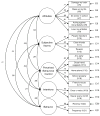Pathways from parental knowledge and warmth to adolescent marijuana use: an extension to the theory of planned behavior
- PMID: 18989783
- PMCID: PMC3088486
- DOI: 10.1007/s11121-008-0111-z
Pathways from parental knowledge and warmth to adolescent marijuana use: an extension to the theory of planned behavior
Abstract
Despite research indicating that effective parenting plays an important protective role in adolescent risk behaviors, few studies have applied theory to examine this link with marijuana use, especially with national data. In the current study (N = 2,141), we hypothesized that parental knowledge (of adolescent activities and whereabouts) and parental warmth are antecedents of adolescents' marijuana beliefs-attitudes, subjective norms, and perceived behavioral control-as posited by the Theory of Planned Behavior (TPB; Ajzen 1991). These three types of beliefs were hypothesized to predict marijuana intention, which in turn was hypothesized to predict marijuana consumption. Results of confirmatory factor analyses corroborated the psychometric properties of the two-factor parenting structure as well as the five-factor structure of the TPB. Further, the proposed integrative predictive framework, estimated with a latent structural equation model, was largely supported. Parental knowledge inversely predicted pro-marijuana attitudes, subjective norms, and perceived behavioral control; parental warmth inversely predicted pro-marijuana attitudes and subjective norms, ps < .001. Marijuana intention (p < .001), but not perceived behavioral control, predicted marijuana use 1 year later. In households with high parental knowledge, parental warmth also was perceived to be high (r = .54, p < .001). Owing to the analysis of nationally representative data, results are generalizable to the United States population of adolescents 12-18 years of age.
Figures



Similar articles
-
Extension of the Theory of Planned Behavior (TPB) to Predict Patterns of Marijuana Use among Young Iranian Adults.Int J Environ Res Public Health. 2020 Mar 17;17(6):1981. doi: 10.3390/ijerph17061981. Int J Environ Res Public Health. 2020. PMID: 32192209 Free PMC article.
-
Perceived Access and Parental Monitoring as Moderators of Impulsivity and Marijuana Use Among Adolescents.J Prim Prev. 2018 Apr;39(2):155-169. doi: 10.1007/s10935-018-0503-1. J Prim Prev. 2018. PMID: 29476375
-
Parental Involvement and Adolescents' Academic Achievement: Latent Profiles of Mother and Father Warmth as a Moderating Influence.Fam Process. 2020 Jun;59(2):772-788. doi: 10.1111/famp.12450. Epub 2019 Apr 14. Fam Process. 2020. PMID: 30982962
-
Racial-Ethnic Discrimination and Early Adolescents' Behavioral Problems: The Protective Role of Parental Warmth.J Am Acad Child Adolesc Psychiatry. 2025 Feb;64(2):249-261. doi: 10.1016/j.jaac.2024.03.020. Epub 2024 May 6. J Am Acad Child Adolesc Psychiatry. 2025. PMID: 38718977
-
Extending the theory of planned behavior to predict alcohol, tobacco, and marijuana use among youth of Mexican heritage.Prev Sci. 2009 Mar;10(1):41-53. doi: 10.1007/s11121-008-0110-0. Prev Sci. 2009. PMID: 18985451
Cited by
-
Washington State recreational marijuana legalization: parent and adolescent perceptions, knowledge, and discussions in a sample of low-income families.Subst Use Misuse. 2015 Apr;50(5):541-5. doi: 10.3109/10826084.2014.952447. Epub 2015 Feb 11. Subst Use Misuse. 2015. PMID: 25671633 Free PMC article.
-
Polygenic and environmental influences on the course of African Americans' alcohol use from early adolescence through young adulthood.Dev Psychopathol. 2020 May;32(2):703-718. doi: 10.1017/S0954579419000701. Dev Psychopathol. 2020. PMID: 31256767 Free PMC article.
-
Factors mediating the association of the recency of parent's marijuana use and their adolescent children's subsequent initiation.Psychol Addict Behav. 2013 Sep;27(3):848-53. doi: 10.1037/a0032201. Epub 2013 Apr 15. Psychol Addict Behav. 2013. PMID: 23586448 Free PMC article.
-
Longitudinal links between fathers' and mothers' harsh verbal discipline and adolescents' conduct problems and depressive symptoms.Child Dev. 2014 May-Jun;85(3):908-923. doi: 10.1111/cdev.12143. Epub 2013 Sep 3. Child Dev. 2014. PMID: 24001259 Free PMC article.
-
Longitudinal family effects on substance use among an at-risk adolescent sample.Addict Behav. 2015 Feb;41:185-91. doi: 10.1016/j.addbeh.2014.10.017. Epub 2014 Oct 24. Addict Behav. 2015. PMID: 25452064 Free PMC article.
References
-
- Ajzen I. Attitudes, personality, and behavior. Milton-Keynes, England: Open University Press; 1988.
-
- Ajzen I. The theory of planned behaviour. Organizational Behavior and Human Decision Processes. 1991;50:179–211. doi: 10.1016/0749-5978(91)90020-T. - DOI
-
- Ajzen I, Cote NG. Attitudes and the prediction of behavior. In: Crano WD, Prislin R, editors. Attitudes and attitude change. New York: Psychology; 2008. pp. 289–311.
-
- Ajzen I, Fishbein M. Understanding attitudes and predicting social behavior. Englewood Cliffs, NJ: Prentice Hall; 1980.
-
- Ajzen I, Madden TJ. Prediction of goal-directed behavior: Attitudes, intentions, and perceived behavioral control. Journal of Experimental Social Psychology. 1986;22:453–474. doi: 10.1016/0022-1031(86)90045-4. - DOI
Publication types
MeSH terms
Grants and funding
LinkOut - more resources
Full Text Sources
Medical

